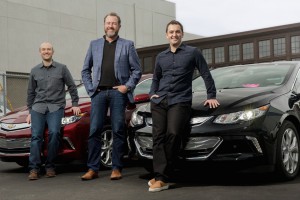General Motors appears to be getting more than just a Lyft, it’s getting a Sidecar too. The automaker bought the assets of the defunct Sidecar Technologies Inc., a ride-sharing company that halted operations last month.
The move comes just two weeks after automaker invested $500 million in Lyft, another ride-sharing company, saying at the time it was looking to expand its reach into the urban mobility realm, but suggesting that would be the end of its check-writing.
The addition of Sidecar, which includes 20 employees, including co-founder and chief technology officer Jahan Khanna, for less than the $39 million Sidecar was able raise in an attempt to compete with Lyft and Uber, according to Bloomberg, gives the company a few more resources. Sidecar not only offered ride-sharing services, but B2B delivery services as well.
According to a statement from GM, the automaker has “attracted Sidecar employees to be integrated into the GM urban mobility team, and acquired certain related assets, for work on our global mobility programs.”
Sidecar shut down at the end of 2015 after not being able to keep up with Lyft and Uber.

GM President Dan Ammann, center, was all smiles after announcing the automaker is investing $500 million with Lyft.
As part of its investment in Lyft, GM gained a seat on the ride-sharing company’s board, which GM President Dan Ammann is currently occupying. Ammann said in a statement at the time of the Lyft deal that the automaker was looking for ways to become a player in the mobility market.
(GM gives ride-share company a $500M Lyft. For details, Click Here.)
“We see the future of personal mobility as connected, seamless and autonomous,” he said. “With GM and Lyft working together, we believe we can successfully implement this vision more rapidly.”
The moves came after Ford already made inroads into the personal mobility arena. Ford Motor Co. CEO Mark Fields has said his company is working on its own ride-sharing service.
At a background briefing for reporters last month, Ford CEO Fields said his goal was to have “one foot in the future,” recognizing that as cities around the world grow larger and roadways more crowded, many consumers will seek alternatives to vehicle ownership.
One of those “feet” was thought to include Google. The automaker was expected to make an announcement about a deal with the tech giant to produce a fleet of autonomous vehicles, which could be used as part of a ride-share service, but nothing came of it during Fields presentation at the Detroit Auto Show.
When asked to comment on the Google partnership, a Ford spokesman e-mailed a statement noting, “We have been and will continue working with many companies and discussing a variety of subjects related to our Ford Smart Mobility plan. We keep these discussions private for obvious competitive reasons, and we do not comment on speculation.”
But Fields has been a vocal proponent of alternative mobility technologies, from autonomous vehicles to ride-sharing, and has ramped up Ford’s efforts since taking over as CEO in mid-2014.
(Click Here for details about a potential partnership between Ford and Google.)
As part of that effort, the automaker is testing the Dynamic Shuttle Project. It is a fleet of 21 modified Ford Transit vans operating like a cross between a bus system and the increasingly popular Uber ride-share service, helping hundreds of employees schedule rides between Ford buildings through a smartphone app.
The Dynamic Shuttle Project — also known as GoRide — is meant to be more flexible than a traditional bus network, allowing users to travel door-to-door, though they may have to wait while the shuttle picks up and drops off other riders.
The key to making it efficient is the use of a dedicated data system that automatically decides which Transit van to use once a ride request is submitted by a smartphone app.
Currently, the service is limited to Ford employees traveling between 129 different locations in Dearborn. Eventually, the service could expand beyond the maker’s campus, however.
In London, Ford has set up the GoDrive service. It’s similar to existing carsharing operations like ZipCar, but with a couple twists. One of the most significant is that a customer doesn’t have to return the vehicle to the original location. And Ford guarantees there will be parking when a motorist reaches their destination.
(To see more about Ford’s pursuit of carsharing and other multi-modal alternatives, Click Here.)
Other makers, including Mercedes-Benz, are looking at ways to exploit the ride-share market as part of an effort to get their share of what industry executives and analysts expect will be a multibillion-dollar business segment in the years ahead.

